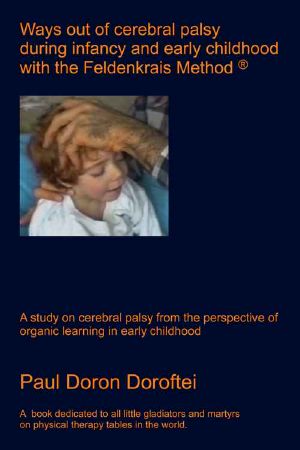Ways Out of Cerebral Palsy During Infancy and Early Childhood With the Feldenkrais Method · A Study on Cerebral Palsy From the Perspective of Organic Learning in Early Childhood

- Authors
- Doroftei, Paul Doron & Feldenkrais, Moshé
- Tags
- education & teaching , alternative therapies , teacher resources , parent participation , health; fitness & dieting , schools & teaching , alternative medicine
- Date
- 2014-11-09T00:00:00+00:00
- Size
- 0.16 MB
- Lang
- en
This book is about cerebral palsy as a general phenomenon concerning functional learning and development of the personality. The reader will find insights in the phenomenon of cerebral palsy from a subjective point of view which will help him for a better understanding what a cerebral palsy infant needs in order to develop and grow as any healthy child.
The notion of “subjective” needs in the learning context, generally and specifically in that of functional development in case of children with cerebral palsy to be nearly specified. Learning, any kind of learning happens through the interaction of the given person with its medium, be this medium human or object based, as in case of learning a specific language where human interaction is imperative or in case of learning to play a specific music instrument. Any acquired information is done through the communication between at least two nervous systems and it needs the subjective senses of the involved persons.
This kind of communication cannot exist without the subjective world of each person, which is capable to discern, to sense, feel and think subjectively. One has first to learn from at least one other person the letters of the Chinese alphabet in order to be able thereafter to teach them to another person. One has first to sense how it feels like to be spastic in order to really have an idea of how to handle a spastic child and help him out of his spasticity, the same as a driver has to see the way where he or she is driving.
“Discovery of how our brain functions may take many centuries yet just because we look outside for its manifestation.” (Moshe Feldenkrais – The Elusive Obvious, On Learning)
Only when we learn how we can reduce our own spasticity which more or less everyone has, can we really know how to reduce the spasticity by others.
As simple and incredible it may sound, you will have the opportunity with this book to realize that only supporting touch without expectations of any results can liberate an infant from his handicap. To say it in the words of Feldenkrais, this is a touch with “that kind of attitude which the therapist today, if he touches you... (he makes you feel that) there's somebody outside which is a real friend to you, and a real friend in that sense that he doesn't want (to get) anything at all from you, anything to gain from you, just to assist you to get a better contact to yourself.” This “better contact to yourself” represents the key to any functional improvement and development.
Without a personal approach and touch which makes you feel that “there's somebody outside which is a real friend to you” no handicapped or not handicapped infant or child can develop healthy. The anonym touch of “aggressive physical therapy and appropriate splinting and casting” (Miller, G. and Clark, G.D. – 1998) is incompatible with any functional learning and development. No performance sportsman, no musician and no dancer could acquire any skills through casting, splinting or any other kind of coercive procedures, as we still today find in so many procedures applied to cerebral palsy infants and children. The destroyed hip-joint of a badly trained dancer through stretching exercises is only one example out of many.
In this book you will find many quotations underlining the positive, pleasant experience characteristic to the Feldenkrais method concerning functional learning, in general, and cerebral palsy, specifically.
Every experience is first subjective in order to be furthered to the others. This book intends to spread this subjective positive experience I could get since my first lesson by Moshe Feldenkrais in the spring of 1972.